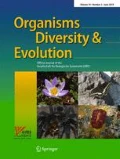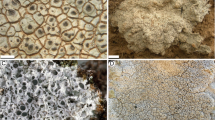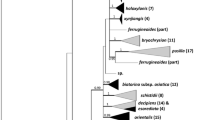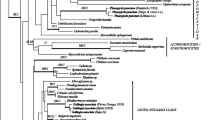Abstract
Recent taxonomic and DNA sequence-based studies in several groups of lichen-forming fungi have revealed incongruence between the morphological and molecule-based circumscriptions of species. While the cosmopolitan genus Usnea is well-known and easily recognized by the yellowish beard-like thallus with central cord, delimitation of many Usnea species is difficult due to the high variation and complexity of diagnostic characters. In this study, we assessed the monophyly of 18 species from section Usnea occurring in North America and Europe, including sorediate and sexually reproducing taxa with both pendent and shrubby thalli. Six nuclear markers (ribosomal internal transcribed spacer (ITS) and intergenic spacer (IGS), and protein-coding beta-tubulin, MCM7, RPB1 and RPB2) were sequenced for 144 samples. All analyzed loci show weak genetic structure and short branch lengths in single-locus topologies, suggesting recent diversification history of the sampled taxa. Concatenated, multi-locus analyses conducted in Bayesian and maximum likelihood frameworks, as well as coalescent-based species delimitation and species tree methods, recover several distinct clades, some represent traditional morphology-based species (Usnea cavernosa, U. praetervisa, U. silesiaca, U. wasmuthii), while others form clusters of two or more species (Usnea florida–U. subfloridana, U. fulvoreagens–U. glabrescens, U. barbata–U. chaetophora–U. dasopoga–U. diplotypus, U. barbata–U. intermedia–U. lapponica–U. substerilis). We propose synonymization of U. substerilis under U. lapponica. The status of several other species within intermixed clusters requires further evaluation with more extensive sampling and the inclusion of more variable markers before taxonomic consequences can be considered. A new species, Usnea parafloridana is described from Wisconsin, USA.





Similar content being viewed by others
References
Akaike, H. (1974). A new look at the statistical model identification. IEEE Transactions on Automatic Control, 19(6), 716–723.
Articus, K. (2004a). Neuropogon and the phylogeny of Usnea s.l. (Parmeliaceae, Lichenized Ascomycetes). Taxon, 53(4), 925–934.
Articus, K. (2004b). Phylogenetic studies in Usnea (Parmeliaceae) and allied genera (Vol. 931, Acta Universitatis Upsaliensis. Comprehensive summaries of Uppsala Dissertations from the Faculty of Science and Technology). Uppsala: Acta Universitatis Upsaliensis.
Articus, K., Mattsson, J.-E., Tibell, L., Grube, M., & Wedin, M. (2002). Ribosomal DNA and β-tubulin data do not support the separation of the lichens Usnea florida and U. subfloridana as distinct species. Mycological Research, 106(4), 412–418.
Boni, M. F., Posada, D., & Feldman, M. W. (2007). An exact nonparametric method for inferring mosaic structure in sequence triplets. Genetics, 176, 1035–1047.
Bouckaert, R., Heled, J., Kühnert, D., Vaughan, T., Wu, C.-H., Xie, D., et al. (2014). BEAST 2: a software platform for Bayesian evolutionary analysis. PLoS Computational Biology, 10(4), e1003537. doi:10.1371/journal.pcbi.1003537.
Carbone, I., & Kohn, L. M. (1999). A method for designing primer sets for speciation studies in filamentous Ascomycetes. Mycologia, 91(3), 553–556.
Carstens, B. C., & Knowles, L. L. (2007). Estimating species phylogeny from gene-tree probabilities despite incomplete lineage sorting: an example from Melanoplus grasshoppers. Systematic Biology, 56(3), 400–411.
Carstens, B. C., Pelletier, T. A., Reid, N. M., & Satler, J. D. (2013). How to fail at species delimitation. Molecular Ecology, 22(17), 4369–4383.
Clerc, P. (1984). Contribution à la revision de la systématique des Usnées (Ascomycotina, Usnea) d'Europe. I. Usnea florida (L.) Wigg. emend. Clerc. Cryptogamie. Bryologie and Lichénologie, 5, 333–360.
Clerc, P. (1987). Systematics of the Usnea fragilescens aggregate and its distribution in Scandinavia. Nordic Journal of Botany, 7(4), 479–495.
Clerc, P. (1998). Species concepts in the genus Usnea (lichenized Ascomycetes). The Lichenologist, 30(4–5), 321–340.
Clerc, P. (2004). Notes on the genus Usnea Adanson. II. Bibliotheca Lichenologica, 88, 79–90.
Clerc, P. (2007). Usnea. In T. H. Nash III, C. Gries, & F. Bungartz (Eds.), Lichen flora of the Greater Sonoran Desert Region (Vol. 3) (p. 327). Tempe: Arizona State.
Clerc, P. (2011). Usnea. In A. Thell, & R. Moberg (Eds.), Nordic Lichen Flora 4. (pp. 107–127): Museum of Evolution, Uppsala University.
R Core Team (2014). R: a language and environment for statistical computing. R Foundation for Statistical Computing, Vienna, Austria. http://www.R-project.org
Cornejo, C., Chabanenko, S., & Scheidegger, C. (2009). Phylogenetic analysis indicates transitions from vegetative to sexual reproduction in the Lobaria retigera group (Lecanoromycetidae, Ascomycota). The Lichenologist, 41(03), 275–284.
Darriba, D., Taboada, G. L., Doallo, R., & Posada, D. (2012). jModelTest 2: more models, new heuristics and parallel computing. Nature Methods, 9(8), 772–772.
Delport, W., Poon, A. F., Frost, S. D., & Pond, S. L. (2010). Datamonkey 2010: a suite of phylogenetic analysis tools for evolutionary biology. Bioinformatics, 26, 2455–2457.
Drummond, A. J., Ho, S. Y., Phillips, M. J., & Rambaut, A. (2006). Relaxed phylogenetics and dating with confidence. PLoS Biology, 4(5), e88. doi:10.1371/journal.pbio.0040088.
Drummond, A. J., Suchard, M. A., Xie, D., & Rambaut, A. (2012). Bayesian Phylogenetics with BEAUti and the BEAST 1.7. Molecular Biology and Evolution, 29(8), 1969–1973.
Edwards, S. V. (2009). Is a new and general theory of molecular systematics emerging? Evolution, 63(1), 1–19.
Edwards, D. L., & Knowles, L. L. (2014). Species detection and individual assignment in species delimitation: can integrative data increase efficacy? Proceedings of the Royal Society B, 281(1777), 20132765. doi:10.1098/rspb.2013.2765.
Elix, J. A., Corush, J., & Lumbsch, H. T. (2009). Triterpene chemosyndromes and subtle morphological characters characterise lineages in the Physcia aipolia group in Australia (Ascomycota). Systematics and Biodiversity, 7(4), 479–487.
Fos, S., & Clerc, P. (2000). The lichen genus Usnea on Quercus suber in Iberian cork-oak forests. The Lichenologist, 32(1), 67–88.
Fujita, M. K., Leaché, A. D., Burbrink, F. T., McGuire, J. A., & Moritz, C. (2012). Coalescent-based species delimitation in an integrative taxonomy. Trends in Ecology & Evolution, 27(9), 480–488.
Gardes, M., & Bruns, T. D. (1993). ITS primers with enhanced specificity for basidiomycetes – application to the identification of mycorrhizae and rusts. Molecular Ecology, 2(2), 113–118.
Giarla, T. C., & Esselstyn, J. A. (2015). The challenges of resolving a rapid, recent radiation: empirical and simulated phylogenomics of Philippine shrews. Systematic Biology. doi:10.1093/sysbio/syv029.
Gibbs, M. J., Armstrong, J. S., & Gibbs, A. J. (2000). Sister-Scanning: a Monte Carlo procedure for assessing signals in recombinant sequences. Bioinformatics, 16, 573–582.
Givnish, T. J. (2015). Adaptive radiation versus ‘radiation’ and ‘explosive diversification’: why conceptual distinctions are fundamental to understanding evolution. New Phytologist, 207(2), 297–303.
Glass, N. L., & Donaldson, G. C. (1995). Development of primer sets designed for use with the PCR to amplify conserved genes from filamentous Ascomycetes. Applied and Environmental Microbiology, 61(4), 1323–1330.
Halonen, P. (2000). Usnea pacificana, sp. nov. and U. wasmuthii (Lichenized Ascomycetes) in Pacific North America. The Bryologist, 103(1), 38–43.
Halonen, P., Clerc, P., Goward, T., Brodo, I. M., & Wulff, K. (1998). Synopsis of the genus Usnea (lichenized Ascomycetes) in British Columbia, Canada. Bryologist, 101, 36–60.
Halonen, P., Myllys, L., Ahti, T., & Petrova, O. V. (1999). The lichen genus Usnea in East Fennoscandia. III. The shrubby species. Annales Botanici Fennici, 36, 235–256.
Heled, J., & Drummond, A. J. (2010). Bayesian inference of species trees from multilocus data. Molecular Biology and Evolution, 27(3), 570–580.
Huelsenbeck, J. P., & Ronquist, F. (2001). MRBAYES: Bayesian inference of phylogenetic trees. Bioinformatics, 17(8), 754–755.
Jones, G. R. (2015). STACEY: species delimitation and phylogeny estimation under the multispecies coalescent. doi:10.1101/010199. Preprint in biorxiv.org.
Jones, G., Zeynep, A., & Oxelman, B. (2014). DISSECT: an assignment-free Bayesian discovery method for species delimitation under the multispecies coalescent. Bioinformatics, 31, 991–998.
Katoh, K., & Standley, D. M. (2013). MAFFT multiple sequence alignment software version 7: improvements in performance and usability. Molecular Biology and Evolution, 30(4), 772–780.
Katoh, K., & Toh, H. (2008). Recent developments in the MAFFT multiple sequence alignment program. Briefings in Bioinformatics, 9(4), 286–298.
Kelly, L. J., Hollingsworth, P. M., Coppins, B. J., Ellis, C. J., Harrold, P., Tosh, J., et al. (2011). DNA barcoding of lichenized fungi demonstrates high identification success in a floristic context. New Phytologist, 191(1), 288–300.
Kimura, M. (1980). A simple method for estimating evolutionary rate of base substitutions through comparative studies of nucleotide sequences. Journal of Molecular Evolution, 16, 111–120.
Knowles, L. L., & Kubatko, L. S. (2010). Estimating species trees: practical and theoretical aspects. Hoboken: Wiley-Blackwell.
Kosakovsky Pond, S. L., Posada, D., Gravenor, M. B., Woelk, C. H., & Frost, S. D. W. (2006). GARD: a genetic algorithm for recombination detection. Bioinformatics, 22(24), 3096–3098.
Kraichak, E., Divakar, P. K., Crespo, A., Leavitt, S. D., Nelsen, M. P., Lücking, R., et al. (2015a). A tale of two hyper-diversities: diversification dynamics of the two largest families of lichenized fungi. Scientific Reports, 5, 10028. doi:10.1038/srep10028.
Kraichak, E., Lücking, R., Aptroot, A., Beck, A., Dornes, P., John, V., et al. (2015b). Hidden diversity in the morphologically variable script lichen (Graphis scripta) complex (Ascomycota, Ostropales, Graphidaceae). Organisms Diversity & Evolution, 15(3), 447–458.
Leaché, A. D. (2009). Species tree discordance traces to phylogeographic clade boundaries in North American fence lizards (Sceloporus). Systematic Biology, 58(6), 547–559.
Leavitt, S. D., Fankhauser, J. D., Leavitt, D. H., Porter, L. D., Johnson, L. A., & St. Clair, L. L. (2011a). Complex patterns of speciation in cosmopolitan "rock posy" lichens – discovering and delimiting cryptic fungal species in the lichen-forming Rhizoplaca melanophthalma species-complex (Lecanoraceae, Ascomycota). Molecular Phylogenetics and Evolution, 59(3), 587–602.
Leavitt, S. D., Johnson, L., & St. Clair, L. L. (2011b). Species delimitation and evolution in morphologically and chemically diverse communities of the lichen-forming genus Xanthoparmelia (Parmeliaceae, Ascomycota) in western North America. American Journal of Botany, 98(2), 175–188.
Linda in Arcadia. (2013). Usnea dasopoga, a name to be reinstated for U. filipendula, and its orthography. Taxon, 62(3), 604–605.
Lindblom, L., & Ekman, S. (2006). Genetic variation and population differentiation in the lichen-forming ascomycete Xanthoria parietina on the island Storfosna, central Norway. Molecular Ecology, 15(6), 1545–1559.
Liu, Y. L., Whelen, S., & Hall, B. D. (1999). Phylogenetic relationships among ascomycetes: evidence from an RNA polymerase II subunit. Molecular Biology and Evolution, 16, 1799–1808.
Lumbsch, H. T., & Wirtz, N. (2011). Phylogenetic relationships of the neuropogonoid core group in the genus Usnea (Ascomycota: Parmeliaceae). The Lichenologist, 43(6), 553–559.
Lumbsch, H. T., Ahti, T., Altermann, S., Amo De Paz, G., Aptroot, A., Arup, U., et al. (2011). One hundred new species of lichenized fungi: a signature of undiscovered global diversity. Phytotaxa, 18, 1–127.
Madden, T. (2002). The BLAST sequence analysis tool. In J. McEntyre & J. Ostell (Eds.), The NCBI handbook. Bethesda: National Center for Biotechnology Information.
Maddison, W. P. (1997). Gene trees in species trees. Systematic Biology, 46(3), 523–536.
Maddison, W. P., & Maddison, D. R. (2011). Mesquite: a modular system for evolutionary analysis. Version 2.75. http://mesquiteproject.org.
Martin, D., & Rybicki, E. (2000). RDP: detection of recombination amongst aligned sequences. Bioinformatics, 16, 562–563.
Martin, D. P., Posada, D., Crandall, K. A., & Williamson, C. (2005). A modified bootscan algorithm for automated identification of recombinant sequences and recombination breakpoints. AIDS Research and Human Retroviruses, 21, 98–102.
Martin, D. P., Lemey, P., Lott, M., Moulton, V., Posada, D., & Lefeuvre, P. (2010). RDP3: a flexible and fast computer program for analyzing recombination. Bioinformatics, 26(19), 2462–2463.
Mason-Gamer, R. J., & Kellogg, E. A. (1996). Testing for phylogenetic conflict among molecular data sets in the tribe Triticeae (Gramineae). Systematic Biology, 45(4), 524–545.
Matheny, P. B., Liu, Y. J., Ammirati, J. F., & Hall, B. D. (2002). Using RPB1 sequences to improve phylogenetic inference among mushrooms (Inocybe, Agaricales). American Journal of Botany, 89(4), 688–698.
Maynard Smith, J. (1992). Analyzing the mosaic structure of genes. Journal of Molecular Evolution, 34, 126–129.
McCune, B. (2005). Usnea in Pacific Northwest. http://people.oregonstate.edu/~mccuneb/Usnea.PDF Accessed 25 Feb 2015.
McEvoy, M., Nybakken, L., Solhaug, K. A., & Gauslaa, Y. (2006). UV triggers the synthesis of the widely distributed secondary lichen compound usnic acid. Mycological Progress, 5(4), 221–229.
Molina, M. C., Del-Prado, R., Divakar, P. K., Sánchez-Mata, D., & Crespo, A. (2011). Another example of cryptic diversity in lichen-forming fungi: the new species Parmelia mayi (Ascomycota: Parmeliaceae). Organisms Diversity & Evolution, 11(5), 331–342.
Motyka, J. (1936). Lichenum generis Usnea studium monographicum. Pars systematica (2 vol. in 1 bd.). Lublin: Editio et proprietas auctoris.
Ohmura, Y. (2001). Taxonomic study of the genus Usnea (lichenized Ascomycetes) in Japan and Taiwan. Journal of Hattori Botanical Laboratory, 90, 1–96.
Ohmura, Y. (2002). Phylogenetic evaluation of infrageneric groups of the genus Usnea based on ITS regions in rDNA. Journal of Hattori Botanical Laboratory, 92, 231–243.
Ohmura, Y., & Kanda, H. (2004). Taxonomic status of section Neuropogon in the genus Usnea elucidated by morphological comparisons and ITS rDNA sequences. The Lichenologist, 36(3–4), 217–225.
O'Meara, B. C., Ané, C., Sanderson, M. J., & Wainwright, P. C. (2006). Testing for different rates of continuous trait evolution using likelihood. Evolution, 60(5), 922–933.
Orange, A., James, P. W., & White, F. J. (2001). Microchemical methods for the identification of Lichens. London: British Lichen Society.
Padidam, M., Sawyer, S., & Fauquet, C. M. (1999). Possible emergence of new geminiviruses by frequent recombination. Virology, 265, 218–225.
Poelt, J. (1970). Das Konzept der Artenpaare bei den Flechten. Vorträge aus dem Gesamtgebiet der Botanik, Neue Folge, 4, 187–198.
Pons, J., Barraclough, T. G., Gomez-Zurita, J., Cardoso, A., Duran, D. P., Hazell, S., et al. (2006). Sequence-based species delimitation for the DNA taxonomy of undescribed insects. Systematic Biology, 55(4), 595–609.
Posada, D., & Crandall, K. A. (2001). Evaluation of methods for detecting recombination from DNA sequences: computer simulations. PNAS, 98, 13757–13762.
Rambaut, A. (2009). FigTree. Version 1.3.1. http://tree.bio.ed.ac.uk/software/figtree. Edinburgh: Institute of Evolutionary Biology, University of Edinburgh.
Rambaut, A., & Drummond, A. (2007). Tracer. Version 1.4. http://beast.bio.ed.ac.uk.
Rambaut, A., & Drummond, A. (2012a). LogCombiner Version 1.7.2. http://beast.bio.ed.ac.uk.
Rambaut, A., & Drummond, A. (2012b). TreeAnnotator Version 1.7.2. http://beast.bio.ed.ac.uk.
Randlane, T., Tõrra, T., Saag, A., & Saag, L. (2009). Key to European Usnea species. The Diversity of Lichenology: Jubilee Volume, 100(100), 419–462.
Ronquist, F., Teslenko, M., van der Mark, P., Ayres, D. L., Darling, A., Höhna, S., et al. (2012). MrBayes 3.2: efficient Bayesian phylogenetic inference and model choice across a large model space. Systematic Biology, 61(3), 539–542.
Saag, L., Tõrra, T., Saag, A., Del-Prado, R., & Randlane, T. (2011). Phylogenetic relations of European shrubby taxa of the genus Usnea. The Lichenologist, 43(05), 427–444.
Saag, L., Mark, K., Saag, A., & Randlane, T. (2014). Species delimitation in the lichenized fungal genus Vulpicida (Parmeliaceae, Ascomycota) using gene concatenation and coalescent-based species tree approaches. American Journal of Botany, 101(12), 2169–2182.
Sanderson, M. J., & Donoghue, M. J. (1996). Reconstructing shifts in diversification rates on phylogenetic trees. Trends in Ecology & Evolution, 11(1), 15–20.
Scherrer, S., Zippler, U., & Honegger, R. (2005). Characterisation of the mating-type locus in the genus Xanthoria (lichen-forming ascomycetes, Lecanoromycetes). Fungal Genetics and Biology, 42(12), 976–988.
Schmitt, I., & Lumbsch, H. T. (2004). Molecular phylogeny of the Pertusariaceae supports secondary chemistry as an important systematic character set in lichen-forming ascomycetes. Molecular Phylogenetics and Evolution, 33(1), 43–55.
Schmitt, I., Crespo, A., Divakar, P. K., Fankhauser, J. D., Herman-Sackett, E., Kalb, K., et al. (2009). New primers for promising single-copy genes in fungal phylogenetics and systematics. Persoonia, 23, 35–40.
Seymour, F. A., Crittenden, P. D., Wirtz, N., Øvstedal, D. O., Dyer, P. S., & Lumbsch, H. T. (2007). Phylogenetic and morphological analysis of Antarctic lichen-forming Usnea species in the group Neuropogon. Antarctic Science, 19(1), 71–82.
Singh, G., Dal Grande, F., Divakar, P. K., Otte, J., Leavitt, S. D., Szczepanska, K., et al. (2015). Coalescent-based species delimitation approach uncovers high cryptic diversity in the cosmopolitan lichen-forming fungal genus Protoparmelia (Lecanorales, Ascomycota). PLoS One, 10(5), e0124625. doi:10.1371/journal.pone.0124625.
Sistrom, M., Donnellan, S. C., & Hutchinson, M. N. (2013). Delimiting species in recent radiations with low levels of morphological divergence: a case study in Australian Gehyra geckos. Molecular Phylogenetics and Evolution, 68(1), 135–143.
Spinks, P. Q., Thomson, R. C., Pauly, G. B., Newman, C. E., Mount, G., & Shaffer, H. B. (2013). Misleading phylogenetic inferences based on single-exemplar sampling in the turtle genus Pseudemys. Molecular Phylogenetics and Evolution, 68, 269–281.
Spitzer, M., Wildenhain, J., Rappsilber, J., & Tyers, M. (2014). BoxPlotR: a web tool for generation of box plots. Nature Methods, 11(2), 121–122.
Spribille, T., Klug, B., & Mayrhofer, H. (2011). A phylogenetic analysis of the boreal lichen Mycoblastus sanguinarius (Mycoblastaceae, lichenized Ascomycota) reveals cryptic clades correlated with fatty acid profiles. Molecular Phylogenetics and Evolution, 59(3), 603–614.
Stamatakis, A. (2006). RAxML-VI-HPC: maximum likelihood-based phylogenetic analyses with thousands of taxa and mixed models. Bioinformatics, 22(21), 2688–2690.
Stamatakis, A., Hoover, P., & Rougemont, J. (2008). A rapid bootstrap algorithm for the RAxML Web servers. Systematic Biology, 57(5), 758–771.
Tamura, K., Peterson, D., Peterson, N., Stecher, G., Nei, M., & Kumar, S. (2011). MEGA5: molecular evolutionary genetics analysis using maximum likelihood, evolutionary distance, and maximum parsimony methods. Molecular Biology and Evolution, 28, 2731–2739.
Tehler, A., & Irestedt, M. (2007). Parallel evolution of lichen growth forms in the family Roccellaceae (Arthoniales, Ascomycota). Cladistics, 23(5), 432–454.
Thell, A., Crespo, A., Divakar, P. K., Kärnefelt, I., Leavitt, S. D., Lumbsch, H. T., et al. (2012). A review of lichen family Parmeliaceae – history, phylogeny and current taxonomy. Nordic Journal of Botany, 30, 641–664.
Tõrra, T., & Randlane, T. (2007). The lichen genus Usnea (lichenized Ascomycetes, Parmeliaceae) in Estonia with a key to the species in the Baltic countries. The Lichenologist, 39, 415–438.
Trest, M. T., Will-Wolf, S., Keuler, R., Shay, N., Hill, K., Studer, A., et al. (2015). Potential impacts of UV exposure on lichen communities: a pilot study of Nothofagus dombeyi trunks in southernmost Chile. Ecosystem Health and Sustainability, 1(4), art14. doi:10.1890/EHS15-0008R1.1.
Truong, C., Divakar, P. K., Yahr, R., Crespo, A., & Clerc, P. (2013). Testing the use of ITS rDNA and protein-coding genes in the generic and species delimitation of the lichen genus Usnea (Parmeliaceae, Ascomycota). Molecular Phylogenetics and Evolution, 68(2), 357–372.
Velmala, S., Myllys, L., Halonen, P., Goward, T., & Ahti, T. (2009). Molecular data show that Bryoria fremontii and B. tortuosa (Parmeliaceae) are conspecific. The Lichenologist, 41(03), 231–242.
Velmala, S., Myllys, L., Goward, T., Holien, H., & Halonen, P. (2014). Taxonomy of Bryoria section Implexae (Parmeliaceae, Lecanoromycetes) in North America and Europe, based on chemical, morphological and molecular data. Annales Botanici Fennici, 51, 345–371.
Wagner, C. E., Keller, I., Wittwer, S., Selz, O. M., Mwaiko, S., Greuter, L., et al. (2013). Genome-wide RAD sequence data provide unprecedented resolution of species boundaries and relationships in the Lake Victoria cichlid adaptive radiation. Molecular Ecology, 22(3), 787–798.
Wedin, M., Westberg, M., Crewe, A. T., Tehler, A., & Purvis, O. W. (2009). Species delimitation and evolution of metal bioaccumulation in the lichenized Acarospora smaragdula (Ascomycota, Fungi) complex. Cladistics, 25(2), 161–172.
Weiller, G. F. (1998). Phylogenetic profiles: a graphical method for detecting genetic recombinations in homologous sequences. Molecular Biology and Evolution, 15, 326–335.
White, T. J., Bruns, T., Lee, S., & Taylor, J. W. (1990). Amplification and direct sequencing of fungal ribosomal RNA genes for phylogenetics. In M. A. Innis, D. H. Gelfand, J. J. Sninsky, & T. J. White (Eds.), PCR protocols: a guide to methods and applications (pp. 315–322). New York: Academic Press.
Wiens, J. J. (1998). Combining data sets with different phylogenetic histories. Systematic Biology, 47(4), 568–581.
Willis, S. C., Farias, I. P., & Ortí, G. (2013). Multi-locus species tree for the Amazonian peacock basses (Cichlidae: Cichla): emergent phylogenetic signal despite limited nuclear variation. Molecular Phylogenetics and Evolution, 69(3), 479–490.
Wirtz, N., Printzen, C., Sancho, L. G., & Lumbsch, H. T. (2006). The phylogeny and classification of Neuropogon and Usnea (Parmeliaceae, Ascomycota) revisited. Taxon, 55(2), 367–376.
Wirtz, N., Printzen, C., & Lumbsch, H. T. (2008). The delimitation of Antarctic and bipolar species of neuropogonoid Usnea (Ascomycota, Lecanorales): a cohesion approach of species recognition for the Usnea perpusilla complex. Mycological Research, 112, 472–484.
Wirtz, N., Printzen, C., & Lumbsch, H. T. (2012). Using haplotype networks, estimation of gene flow and phenotypic characters to understand species delimitation in fungi of a predominantly Antarctic Usnea group (Ascomycota, Parmeliaceae). Organisms Diversity & Evolution, 12(1), 17–37.
Yang, Z., & Rannala, B. (2010). Bayesian species delimitation using multilocus sequence data. Proceedings of the National Academy of Sciences, 107(20), 9264–9269.
Yang, Z., & Rannala, B. (2014). Unguided species delimitation using DNA sequence data from multiple loci. Molecular Biology and Evolution, 31(12), 3125–3135.
Zhang, J., Kapli, P., Pavlidis, P., & Stamatakis, A. (2013). A general species delimitation method with applications to phylogenetic placements. Bioinformatics, 29(22), 2869–2876.
Acknowledgments
We thank the collectors who provided the specimens used here and anonymous reviewers for useful comments. The study was financially supported by the Estonian Research Council (grants ETF9109 and PUT1017 to TR) and European Union Social Fund through the ESF Doctoral Studies and Internationalisation Programme Activity 6. The molecular work was performed in the DNA Genotyping and Sequencing Core Facility of the Estonian Biocentre and Institute of Molecular and Cell Biology at the University of Tartu (Tartu, Estonia) and in the Pritzker Laboratory for Molecular Systematics at the Field Museum (Chicago, IL, USA). Computationally demanding analyses were carried out in the High Performance Computing Center at the University of Tartu.
Author information
Authors and Affiliations
Corresponding author
Ethics declarations
Conflict of interest
The authors declare that they have no conflict of interest.
Ethical approval
This article does not contain any studies with human participants or animals performed by any of the authors.
Additional information
An erratum to this article is available at http://dx.doi.org/10.1007/s13127-016-0311-5.
Electronic supplementary material
Below is the link to the electronic supplementary material.
Online Resource 1
Fig. S1–S6 Majority rule consensus trees inferred from ML analysis on ITS (Fig. S1), IGS (Fig. S2), beta-tubulin (Fig. S3), MCM7 (Fig. S4), RPB1 (Fig. S5) and RPB2 (Fig. S6) datasets together with nonparametric bootstrap support (BP) and posterior probability (PP) values from Bayesian inference. Above branch is indicated ML bootstrap probabilities (BP) and below Bayesian posterior probability (PP) scores. Branches marked in bold indicate strong support (BP ≥ 70 and PP ≥ 0.95) for specified clade. Scale bar shows the number of substitutions per site (PDF 339 kb)
Online Resource 2
Fig. S7 Majority rule consensus tree of all available Usnea fulvoreagens, U. glabrescens s.str. and U. pacificana sequences (Table 1) with U. silesiaca as an outgroup, based on six concatenated loci, inferred in RAxML. Clade bootsrap probabilites (BP) are given above branch and strongly supported clades (BP ≥ 70 %) are marked in bold. Scale bar shows the number of substitutions per site. In brackets are given specimen code, country, and secondary chemistry. Secondary metabolites in fulvoreagens-glabrescens clade: bar − barbatic acid; BMY − baeomycesic acid; NSTI − norstictic acid; pro − protocetraric acid; SAL − salazinic acid; SQU − squamatic acid; STI-comp − stictic acid complex with connorstictic cryptostictic acids; unid rfcl x − unidentified substance from reference class x. Capital letters denotes major compounds in chemotype, lower case accessory substances (PDF 136 kb)
Online Resource 3
Fig. S8 Majority rule consensus tree of all studied Usnea parafloridana specimens with some representatives from florida-subfloridana and wasmuthii clades, based on six concatenated loci, inferred in RAxML. Clade bootsrap probabilites (BP) are given above branch and strongly supported clades (BP ≥ 70 %) are marked in bold. Scale bar shows the number of substitutions per site. In brackets are given specimen codes and secondary chemistry. Secondary metabolites in U. parafloridana: NSTI − norstictic acid; SAL − salazinic acid; unid rfcl x − unidentified substance from reference class x. Capital letters denotes major compounds in chemotype, lower case accessory substances (PDF 274 kb)
Online Resource 4
Fig. S9 Examples of lichen substances of some studied Usnea specimens, incl. U. parafloridana sp. nov., identified in thin layer chromatography analyses. Secondary metabolites are visualized in solvent system A, after treatment with sulphuric acid and heating (Orange et al. 2001). Identified secondary metabolites: al – alectorialic acid; bar − barbatic acid; bmy − baeomycesic acid; cnsti – connorstictic acid; csti – cryptostictic acid; nsti – norstictic acid; sal – salazinic acid; squ − squamatic acid; sti – stictic acid; tha – thamnolic acid; usn − usnic acid (PDF 1398 kb)
Rights and permissions
About this article
Cite this article
Mark, K., Saag, L., Leavitt, S.D. et al. Evaluation of traditionally circumscribed species in the lichen-forming genus Usnea, section Usnea (Parmeliaceae, Ascomycota) using a six-locus dataset. Org Divers Evol 16, 497–524 (2016). https://doi.org/10.1007/s13127-016-0273-7
Received:
Accepted:
Published:
Issue Date:
DOI: https://doi.org/10.1007/s13127-016-0273-7




